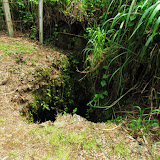 |
| The Fērē Rock (Fere), Onna Village |
View Map It! Okinawa in a larger map
 |
| The Fērē (Fere) Rock |
GPS
| Latitude | Longitude |
| N 26 25.800 | E 127 46.344 |
The Fere Rock (Fērē), Onna Village
Along one of Onna Village's historical trails you will find a very large rock off to the side. If not for a sign, it would be inconspicuous to the regular traveler since large rocks are not uncommon to see on Okinawa. The rock you see above is called the Fērē Rock (フェーレー岩), which loosely translates to as 'The Bandit Rock'. The word Fērē (sometimes written as just Fere) is of the Okinawan language meaning an outlaw. You may not realize it either while you are there, but you are also on Mt Takō, or Takō-yama (多幸山).(1)
How it got its name. Long ago thieves would hide around this large rock waiting to rob ill-fated travelers. One method was to wait on top of the Fere Rock with a pole and a hook and snag belongings from above as travelers passed by. But heroes have also surfaced from such stories as well. In one case, a karate master by the name of Matsumora thwarted off the robbers with a sickle. Another story has it that a woman from Itoman by the name of Chiru successfully keep the robbers at bay.(1)
Author's note. It is not exactly certain by the author which karate master, Matsumora, the resource was referring to since only his last name was given. Additionally, the time frame surrounding the story of the bandits is also not certain since no dates were provided. It is the author's belief that it was several centuries ago, possibly in the 17th or 18th Century. This is pending further research. The Fere Rock sits along an extensive historical trail that covers the Yamada Castle Ruins and other notable historical areas soon to be mapped.
Source of Information. 1. Onna Village History and Culture Publication dated March 2000, published by the Onna Village Office.
Directions. Take Highway 58 and then get on Highway 6 as if you are going to Maeda Point. Your first LandMark is the tourist sign for Cape Maeda (designated by the LandMark pin in the map). The next LandMark is almost immediately after the Cape Maeda sign. It is designated by a small blue sign with the Katakana writing that as seen in this picture or looks like this when written 'フェーレー'岩' . This is where you turn off. Follow this road south for 1km. It may seem somewhat windy but eventually you will see the rock on the left-hand side with a historical sign written in Japanese.



